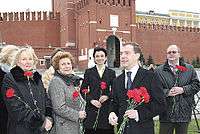Unity Day (Russia)
| Unity Day | |
|---|---|
.jpg) | |
| Official name | Day of People's Unity |
| Observed by |
|
| Significance | Expelling the Polish occupation forces from Moscow in November 1612, end of the Time of Troubles and turning point of the Polish-Muscovite War (1605–1618) |
| Celebrations | Flag hoisting, Parades, Fireworks, Award ceremonies, singing patriotic songs and the National anthem, Speeches by the President, entertainment and cultural programs |
| Date | November 4 |
| Next time | 4 November 2017 |
| Frequency | annual |

Unity Day (also called Day of People’s Unity or National Unity Day; Russian: День народного единства, Denʹ narodnogo yedinstva) is a national holiday in Russia held on November 4 (October 22, Old Style). It commemorates the popular uprising which expelled Polish occupation forces from Moscow in November 1612, and more generally the end of the Time of Troubles and turning point of the Polish-Muscovite War (1605–1618).
The day's name alludes to the idea that all classes of Russian society united to preserve Russian statehood when there was neither a tsar nor a patriarch to guide them. In 1613 tsar Mikhail Romanov instituted a holiday named Day of Moscow’s Liberation from Polish Invaders.[1] It was celebrated in the Russian Empire until 1917, when it was replaced with a commemoration of the Russian Revolution. Unity Day was reinstituted by the Russian Federation in 2005, when the events of the year 1612 have been celebrated instead of those of 1917 every November 4 since. The day is also the feast day of the Russian Orthodox icon of Our Lady of Kazan.
Popularity
According to a poll in 2007, only 23 percent of Russians know the name of the holiday, up from 8 percent in 2005. 22 percent identified the holiday as the Day of Accord and Reconciliation, the name of the holiday on November 7 during the 1990s. Only 4 percent knew that the holiday commemorates the liberation of Moscow from Polish invaders, down from 5 percent in 2005.[2]
Controversy
President Vladimir Putin reestablished the holiday in order to replace the commemoration of the October Revolution, known as The Day of Great October Socialist Revolution during Soviet period and as The Day of Accord and Conciliation in post-Soviet times,[3] which formerly took place on November 7. His decision angered some sections of the public,[4] particularly the Communist Party, who continued with celebrations on November 7. Putin's predecessor, Boris Yeltsin took a limited action of changing the name of the holiday; by completely removing it, Putin sparked a controversy that continues today.
Historical events
2005
The center of the first reinstituted Unity Day was Nizhny Novgorod. The monument to Kuzma Minin and Dmitry Pozharsky was opened there, and President Putin laid flowers there. The Patriarch of Moscow and all Rus', Alexy II also attended. In Moscow, two processions and the "Russian March" passed. Religious processions took place with local heads of administrations.
Several fundraisers were held: in Tula, adistrict art festival took place for children with disabilities, and in Kaluga, veterans and orphans were given local confectionery products.
2006
A "Russian March" took place, despite bans in cities such as Moscow. Nizhny Novgorod planned a 90-minute grand visual show, attended by more than 1,000 actors.
2007
Vladimir Khotinenko made the historical film 1612, telling the story behind the holiday. In Moscow alone 39 events were held. Vladimir Putin traditionally laid flowers at the monument to Minin and Pozharsky and presented the Pushkin Medal at a reception in the Moscow Kremlin, "For the preservation of Russian spiritual heritage" and "promotion of Russian language".
2008

President Dmitry Medvedev laid flowers at the monument to Minin and Pozharsky and organized a reception in the Grand Kremlin Palace. In Revolution Square, 7,000 attended a meeting devoted to the Day of National Unity. Activists of the youth movement "Nashi" called for a day of "under the covers" - 10,000 young people gathered on Vasilevsky Descent Square to sew a patchwork of thousands into the so-called "blanket the world". There was a free rock festival "Call", aimed at combating negative phenomena among young people, such as drugs.
2010
There was a celebration of the consecration of the restored gate icon of St. Nicholas Mozhaiskogo on the Nikolskaya Tower of the Moscow Kremlin, with the participation of the Patriarch of Moscow and all Rus', Kirill I.
2012

The center of celebrations was again Nizhny Novgorod. The organization of the regional government allocated a holiday budget of 15,200,000 rubles. In addition, on November 4 in Nizhny Novgorod, a sculpture 30 meters in length and about 5 meters in height was erected, with the image of Kozma Minin.
See also
| Wikimedia Commons has media related to Day of People’s Unity. |
- Public holidays in Russia
- 1612, a historical fiction movie made for the occasion
- Unity Day (disambiguation), in other countries
- Armed Forces Day (Poland), a holiday in Poland celebrating Polish victory over Russian forces